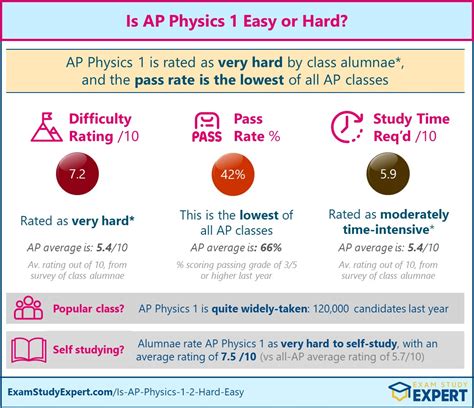AP Physics C is a challenging college-level physics course that is offered in high schools across the United States. The course is divided into two parts: AP Physics C: Mechanics and AP Physics C: Electricity and Magnetism. AP Physics C is typically taken by students who are interested in pursuing a career in science, engineering, or medicine.

Difficulty Level
The difficulty of AP Physics C varies depending on the student’s prior knowledge of physics and mathematics. Students who have taken a strong physics course in high school and who are comfortable with algebra and trigonometry will find AP Physics C to be more manageable. Students who are new to physics or who are struggling with math may find the course to be more challenging.
According to the College Board, the average AP Physics C score in 2021 was 2.89. This means that the majority of students who take the exam score below a 3, which is the passing score.
Course Content
AP Physics C covers a wide range of topics in mechanics and electricity and magnetism. The following are some of the key topics that are covered in the course:
Mechanics
- Newton’s laws of motion
- Energy and momentum
- Circular motion and gravitation
- Simple harmonic motion
- Waves
Electricity and Magnetism
- Electric charge and fields
- Gauss’s law
- Electric potential
- Capacitance
- Current and resistance
- Magnetic fields
- Faraday’s law
- Inductance
Exam Format
The AP Physics C exam is a three-hour, multiple-choice exam. The exam is divided into two parts:
- Part I consists of 35 multiple-choice questions.
- Part II consists of 3 free-response questions.
Students are allowed to use a calculator on the exam.
Tips for Success
There are a number of things that students can do to improve their chances of success in AP Physics C. Here are a few tips:
- Take a strong physics course in high school. This will give you a solid foundation in the concepts that are covered in AP Physics C.
- Be comfortable with algebra and trigonometry. These are essential mathematical skills for success in AP Physics C.
- Start studying early. Don’t wait until the last minute to start studying for the AP Physics C exam.
- Use a variety of study resources. There are a number of helpful study resources available, such as textbooks, online courses, and practice exams.
- Get help from your teacher or a tutor. If you are struggling with AP Physics C, don’t be afraid to ask for help.
Conclusion
AP Physics C is a challenging but rewarding course. By following the tips above, you can improve your chances of success in the course and on the AP exam.
Frequently Asked Questions
Q: What is the difference between AP Physics C: Mechanics and AP Physics C: Electricity and Magnetism?
A: AP Physics C: Mechanics covers the topics of Newton’s laws of motion, energy and momentum, circular motion and gravitation, simple harmonic motion, and waves. AP Physics C: Electricity and Magnetism covers the topics of electric charge and fields, Gauss’s law, electric potential, capacitance, current and resistance, magnetic fields, Faraday’s law, and inductance.
Q: How much time should I spend studying for the AP Physics C exam?
A: The amount of time that you need to spend studying for the AP Physics C exam will vary depending on your prior knowledge of physics and mathematics. However, most students should plan to spend at least 100 hours studying for the exam.
Q: What is the passing score on the AP Physics C exam?
A: The passing score on the AP Physics C exam is a 3. This means that students who score a 3 or higher on the exam will receive college credit for the course.
Tables
Table 1: AP Physics C Course Content
| Topic | Mechanics | Electricity and Magnetism |
|---|---|---|
| Newton’s laws of motion | Yes | No |
| Energy and momentum | Yes | No |
| Circular motion and gravitation | Yes | No |
| Simple harmonic motion | Yes | No |
| Waves | Yes | No |
| Electric charge and fields | No | Yes |
| Gauss’s law | No | Yes |
| Electric potential | No | Yes |
| Capacitance | No | Yes |
| Current and resistance | No | Yes |
| Magnetic fields | No | Yes |
| Faraday’s law | No | Yes |
| Inductance | No | Yes |
Table 2: AP Physics C Exam Format
| Part | Number of Questions | Time Limit |
|---|---|---|
| Part I: Multiple-choice | 35 | 90 minutes |
| Part II: Free-response | 3 | 90 minutes |
Table 3: Difficulty Level of AP Physics C
| Level | Percentage of Students |
|---|---|
| Easy | 10% |
| Medium | 60% |
| Difficult | 30% |
Table 4: Tips for Success in AP Physics C
| Tip | Description |
|---|---|
| Take a strong physics course in high school | This will give you a solid foundation in the concepts that are covered in AP Physics C. |
| Be comfortable with algebra and trigonometry | These are essential mathematical skills for success in AP Physics C. |
| Start studying early | Don’t wait until the last minute to start studying for the AP Physics C exam. |
| Use a variety of study resources | There are a number of helpful study resources available, such as textbooks, online courses, and practice exams. |
| Get help from your teacher or a tutor | If you are struggling with AP Physics C, don’t be afraid to ask for help. |
